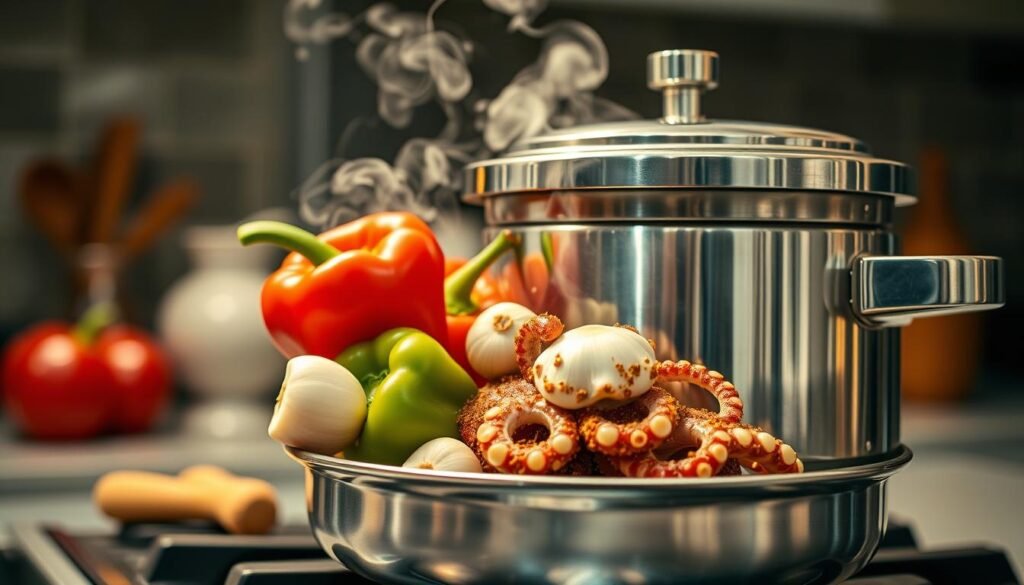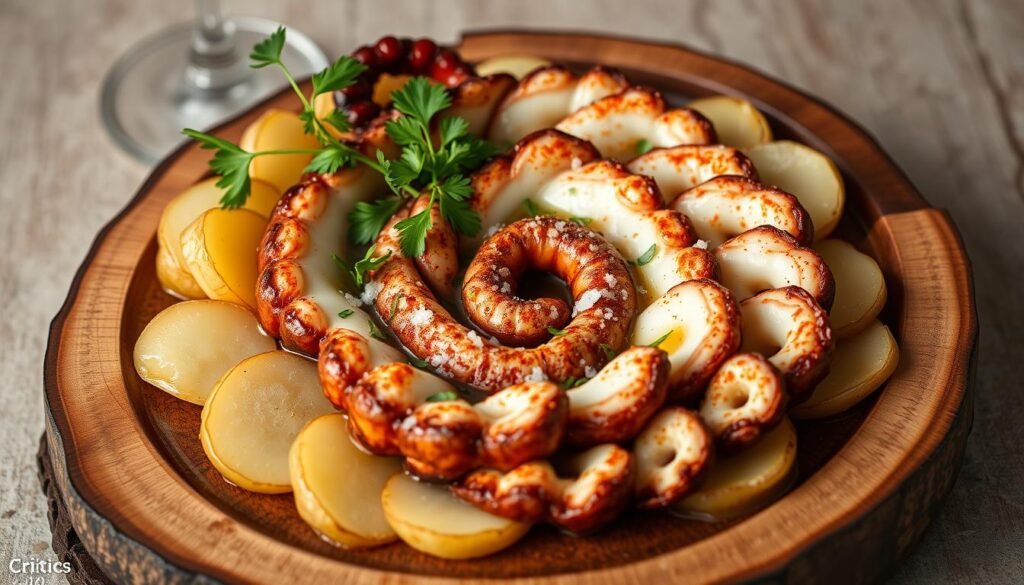
Octopus a la Gallega: A Taste of Galicia
- Dinner
- December 24, 2024
- No Comment
- 667
Imagine walking along Galicia’s rugged coast, where the Atlantic Ocean meets old traditions. The smell of Spanish tapas fills the air. At the center of this journey is pulpo a la gallega, a dish that embodies traditional Spanish cuisine.
This iconic dish is more than a meal; it’s a cultural experience that links past and present. It combines tender octopus, golden potatoes, fragrant olive oil, and vibrant paprika. This mix tells a story of maritime heritage and regional pride.
In small villages and big cities, pulpo a la gallega is a beloved dish. Each bite takes you to Galicia’s rocky shores and rich food scene.
Key Takeaways
- Pulpo a la gallega is a quintessential Spanish tapas dish originating from Galicia
- The recipe showcases simple, high-quality ingredients typical of traditional Spanish cuisine
- Cooking octopus requires specialized techniques to achieve perfect tenderness
- The dish represents the rich maritime culture of Galicia’s 400-kilometer coastline
- Presentation and preparation are as important as the ingredients themselves
The Rich Heritage of Galician Seafood Cuisine
Explore the world of Galician cuisine, where the Atlantic Ocean’s bounty shapes a unique culinary tradition. Northwestern Spain’s seafood heritage is more than just cooking. It’s a celebration of culture, history, and community.
The coastal region of Galicia has a special gastronomic landscape. It’s deeply connected to its maritime environment. Spanish seafood traditions here are not just about food. They represent generations of fishing communities and their bond with the ocean.
Origins in Northwestern Spain
Galician cuisine comes from a rugged landscape where fishing has been crucial for centuries. The traditional recipes show the region’s geographical gifts:
- Abundant marine resources from the Atlantic Ocean
- Rich fishing traditions passed through generations
- Proximity to pristine coastal waters
Cultural Significance in Galicia
Seafood dishes in Galicia are more than just food. They represent cultural identity. Octopus, known locally as pulpo, is a culinary ambassador for the region’s gastronomic heritage.
“In Galicia, every dish tells a story of the sea and the people who have survived by its bounty.”
Traditional Preparation Methods
The art of preparing seafood in Galician cuisine involves careful techniques. These techniques transform simple ingredients into extraordinary meals. Here’s a glimpse into their traditional approach:
| Technique | Purpose |
|---|---|
| Three-dip method | Helps set octopus skin for perfect texture |
| Slow cooking | Ensures tenderness and preserves flavor |
| Minimal seasoning | Highlights ingredient quality |
By embracing simplicity and respecting ingredient quality, Galician chefs create culinary masterpieces. These dishes continue to captivate food enthusiasts worldwide.
Essential Ingredients for Authentic Pulpo a la Gallega
To make the perfect Pulpo a la Gallega, start with the best ingredients. Look for fresh Spanish octopus from the Galician coast. This is the heart of Galician cuisine.
The key ingredients for an authentic experience include:
- Fresh Spanish octopus
- Galician potatoes (preferably Kennebec variety)
- Extra virgin olive oil (Hojiblanca recommended)
- Pimentón de La Vera (Spanish smoked paprika)
“The soul of Pulpo a la Gallega lies in its simple yet exceptional ingredients” – Traditional Galician Chef
When making this dish, focus on the quality of your olive oil and pimentón de La Vera. These two are key to its unique flavor.
Experts say use 2 kg of octopus and 1 kg of potatoes for four people. Each serving has about 106 kcal and 16g of protein.
| Ingredient | Quantity | Quality Marker |
|---|---|---|
| Spanish Octopus | 2 kg | Fresh, Galician waters |
| Galician Potatoes | 1 kg | Kennebec variety |
| Extra Virgin Olive Oil | 200 ml | Hojiblanca type |
| Pimentón de La Vera | 2 tbsp | Smoked paprika |
Pro tip: For the most authentic experience, source your ingredients from specialized Spanish food importers or high-end grocery stores.
Selecting and Preparing the Perfect Octopus
To make Pulpo a la Gallega, you need to pick and prepare the octopus right. Whether it’s fresh or frozen, knowing how to prepare it makes all the difference. This ensures your dish is tender and tasty.
Fresh vs Frozen Octopus: Making the Right Choice
You can choose between fresh or frozen octopus. Fresh octopus should smell like the sea, not fishy. If fresh is hard to find, frozen is a good substitute.
- Fresh octopus recommendation: 1.5 kg (3.3 lbs)
- Thawing time: 24 hours in refrigerator
- Quick thaw option: 30 minutes at room temperature
Cleaning and Preparing Techniques
Cleaning the octopus is key. You must remove the ink sac, eyes, beak, and internal organs. Wear gloves and use a sharp knife for a clean cut.
“The key to great octopus is in the preparation” – Galician Seafood Chef
Tenderizing Methods for Perfect Texture
Getting the right texture is crucial. Chefs suggest a few ways to tenderize:
- Freeze fresh octopus for 1-2 days to break down muscle fibers
- Gently beat the octopus with a meat tenderizer
- Use the traditional “scaring” technique: dip in boiling water three times
| Preparation Method | Cooking Time | Tenderness Indicator |
|---|---|---|
| Boiling | 45-60 minutes | Easily pierce with fork |
| Freezing | 24 hours | Muscle fibers softened |
| Beating | 5-10 minutes | Reduced toughness |
By using these methods, you’ll make a Pulpo a la Gallega that’s both tender and flavorful. It will truly capture the spirit of Galician cuisine.
The Art of Cooking Octopus a la Gallega
Learning to cook octopus well takes patience and care. In Galicia, they make octopus tender and delicious. The traditional way of boiling it is very important.
First, you need to make the octopus tender. Galician chefs use two main ways:
- Beating the octopus with a stone or rolling pin to soften the meat
- Freezing the octopus two days ahead and defrosting in the refrigerator
Boiling the octopus needs the right timing and skill. Here’s how to do it:
| Cooking Stage | Key Details |
|---|---|
| Boiling Time | 40-50 minutes depending on octopus size |
| Tenderness Test | Pierce tentacle near the head with a knife or skewer |
| Cooling | Allow octopus to cool in its cooking liquid |
“The secret to perfect pulpo is in the gentle cooking and patient preparation.” – Galician Chef
After cooking, cut the octopus tentacles into medium thickness. Season with sea salt, pimentón (Spanish paprika), and extra virgin olive oil. Your octopus will now be a true Galician dish, full of the flavors of northwestern Spain.
Traditional Cooking Methods and Timing
Cooking octopus well needs precision and skill. The traditional Galician way involves key steps for a tender and tasty octopus.
Getting octopus right can be tricky. But knowing the right cooking time is key. Chefs use a special method to make this tough seafood delicious.
The Three-Dip Technique
The three-dip method is a beloved tradition in Galicia. Here’s how it works:
- Bring a large pot of water to a rolling boil
- Grasp the octopus by its head
- Dip the tentacles into the boiling water three consecutive times
- On the third dip, fully submerge the octopus
Boiling Time and Temperature
Timing is everything when checking octopus tenderness. For a 1.5 kg octopus, simmer gently for 45-50 minutes.
Testing for Doneness
To check if your octopus is cooked, try this:
- Insert a fork or sharp knife into the thickest part of the tentacle
- If it slides in easily, your octopus is ready
- The meat should feel tender but not mushy
“The secret to perfect octopus is patience and precision.” – Galician Cooking Proverb
After cooking, let the octopus rest and cool. This helps it keep its best texture and soak up flavors.
Pressure Cooker Method: A Modern Approach

Try pressure cooking for a quick octopus recipe. This method cuts down cooking time and keeps the octopus tender.
Pressure cooking is a big help for home cooks who want fast results without losing flavor. Unlike boiling, which takes hours, a pressure cooker cooks octopus in 15-20 minutes.
“Pressure cooking is the secret weapon for transforming tough octopus into a tender delicacy in record time.” – Culinary Innovations Magazine
Key Pressure Cooking Steps
- Select fresh or frozen octopus
- Clean and prepare the octopus thoroughly
- Place octopus in pressure cooker with aromatics
- Cook at high pressure for 15 minutes
- Allow natural pressure release
Pressure Cooking Advantages
- Reduces cooking time by 75%
- Ensures consistent tenderness
- Preserves natural octopus flavor
- Minimizes kitchen effort
Experts say to let the octopus cool in its liquid. This keeps it moist and improves its texture. It makes your dish taste like it’s from a restaurant, with little effort.
| Cooking Method | Time | Tenderness |
|---|---|---|
| Traditional Boiling | 60-90 minutes | Variable |
| Pressure Cooking | 15-20 minutes | Consistent |
Try this modern cooking method to make cooking octopus easy and quick.
Preparing the Perfect Potato Base
The foundation of an exceptional Pulpo a la Gallega lies in selecting and preparing the right Galician potatoes. Your potato choice can make or break this traditional Spanish seafood dish.
Choosing the right potatoes is crucial for achieving the perfect texture in your pulpo dish. Waxy potatoes work best because they maintain their shape during cooking and provide an ideal base for octopus.
Selecting the Ideal Potato Variety
- Look for medium-sized waxy potatoes
- Prefer varieties that hold their shape when boiled
- Avoid starchy potatoes that become mushy
Potato Preparation Techniques
When preparing boiled potatoes for Pulpo a la Gallega, follow these key steps:
- Peel potatoes carefully
- Slice into uniform rounds (approximately 1 cm thick)
- Cook for 20-25 minutes until fork-tender
| Potato Cooking Method | Cooking Time | Texture Result |
|---|---|---|
| Boiling in Octopus Water | 10-15 minutes | Absorbs octopus flavor |
| Separate Boiling | 20-25 minutes | Tender, maintains shape |
The potato texture for pulpo should be tender yet firm, creating a sturdy foundation for your octopus. Pro tip: Cook potatoes until they’re easily pierced with a fork but not falling apart.
“The secret to a perfect Pulpo a la Gallega is in the potato’s texture – it should whisper, not shout.” – Spanish Culinary Expert
Your goal is to create a potato base that complements the octopus without overshadowing its delicate flavor. With these techniques, you’ll master the art of preparing Galician potatoes for an authentic Spanish experience.
The Role of Spanish Paprika and Olive Oil
Seasoning pulpo a la gallega is an art that turns a simple dish into a masterpiece. The secret is in two key ingredients: pimentón de La Vera and Spanish extra virgin olive oil. These traditional seasonings make the octopus taste amazing.
Pimentón de La Vera is the star of this dish. It comes in two main types:
- Dulce (sweet) – has a mild, smoky taste
- Picante (hot) – adds a spicy flavor
When picking your pimentón, think about how spicy you like it. Chefs say to sprinkle it generously over the octopus and potatoes. This makes the dish look and taste like true Galician cuisine.
“The magic of pulpo a la gallega is in its simplicity” – Traditional Galician Saying
Spanish extra virgin olive oil is also key. A good olive oil adds richness and depth. It helps the pimentón stick to the octopus and makes it look glossy and appealing.
| Ingredient | Flavor Profile | Recommended Amount |
|---|---|---|
| Pimentón de La Vera (Sweet) | Mild, Smoky | 1-2 tablespoons |
| Pimentón de La Vera (Hot) | Spicy, Intense | 1-2 tablespoons |
| Spanish Extra Virgin Olive Oil | Rich, Smooth | 2-3 tablespoons |
Finish with a pinch of coarse sea salt. This adds to the octopus’s natural flavors. It makes the dish unforgettable.
Plating and Presentation Techniques
Pulpo a la gallega is a true art form in Spanish food plating. It turns simple ingredients into a stunning visual feast. Your presentation can make this traditional dish look like it’s from a fancy restaurant.

Serving pulpo a la gallega needs careful attention and respect for Galician traditions. The classic way to serve it follows a few key steps. These steps make the dish both beautiful and true to its roots.
Traditional Serving Foundations
- Use a wooden plate (tabla) as the classic serving foundation
- Arrange thinly sliced potatoes as the base layer
- Place octopus pieces strategically on top of potatoes
Elegant Plating Techniques
For a more elegant touch, try these advanced techniques:
- Slice octopus tentacles into uniform pieces
- Arrange tentacle slices in a circular pattern
- Create a symmetrical design on warmed plates
- Garnish with a light sprinkle of pimentón
“Great food is art on a plate” – Galician Culinary Saying
The secret to amazing tapas presentation is simplicity. Let your ingredients speak for themselves. Use simple styling to show off the octopus’s beauty and texture.
Wine Pairing and Serving Suggestions
Choosing the right Spanish white wines can make your Pulpo a la Gallega even better. Galician wines pair perfectly with this dish, adding to the flavor.
Albariño is the best wine for Pulpo a la Gallega. It has a crisp, citrusy taste that goes well with the octopus. The wine’s acidity balances the dish’s richness, making it a perfect match.
Top Wine Recommendations
- Albariño from Rías Baixas – intense green apple and citrus flavors
- Verdejo from Rueda – light-bodied white with refreshing acidity
- Godello – another fascinating Galician white grape variety
Serving Suggestions
Make your Pulpo a la Gallega unforgettable by adding Spanish appetizers. A great selection could include:
- Patatas bravas
- Crispy croquettes
- Crusty bread for olive oil
“The right wine can transform a good dish into an extraordinary culinary journey.” – Spanish Wine Expert
| Wine Type | Origin | Flavor Profile |
|---|---|---|
| Albariño | Rías Baixas, Galicia | Citrusy, high acidity, green apple notes |
| Verdejo | Rueda | Light, crisp, similar to Sauvignon Blanc |
| Godello | Galicia | Mineral, balanced, medium-bodied |
Pro tip: Chill your Spanish white wines to 45-50°F. This will bring out their refreshing qualities and make your meal even better.
Regional Variations and Modern Interpretations
Spanish cuisine is always evolving, especially with dishes like pulpo a la gallega. Chefs are adding new twists to traditional Galician recipes. They keep the essence of the dish but also explore new flavors and techniques.
Octopus recipes in Spain are getting a creative boost. Chefs are trying out new ideas. Here are some examples:
- Incorporating sautéed onions for enhanced flavor complexity
- Grilling octopus after boiling to create a delightful charred exterior
- Preparing octopus carpaccio as a modern appetizer
- Integrating octopus into fresh seafood salads
“The beauty of Spanish cuisine lies in its ability to honor tradition while embracing innovation.” – Spanish Culinary Expert
But, some stick to the traditional way of making pulpo a la gallega. They think the old method lets the octopus’s natural taste stand out. They focus on using the best ingredients and cooking them just right.
Galician food is always evolving, making simple ingredients into amazing dishes. Whether you like the traditional way or something new, pulpo a la gallega shows Spain’s deep love for food.
Conclusion
Pulpo a la Gallega is a symbol of Galicia’s rich food culture. It shows the beauty of simple, traditional Spanish recipes. Exploring this dish is more than just eating; it’s a journey to Spain’s northwestern coast.
The charm of pulpo a la Gallega is in its simplicity. Cooking it means keeping alive a tradition that values quality and tradition. Every piece of tender octopus shares a story of Galicia’s coastal life, where fresh seafood becomes a culinary wonder.
Whether you love cooking or just enjoy food, this dish opens a window into Spanish cuisine. Learning how to make it, using the right ingredients, and understanding its cultural value shows why it’s loved worldwide. It proves that with care, simple things can make a meal unforgettable.
Your food adventure doesn’t stop here. Every time you make or enjoy pulpo a la Gallega, you join a tradition that connects you to Galicia’s lively food scene. It invites you to enjoy not just a meal, but a part of Spanish culinary history.





